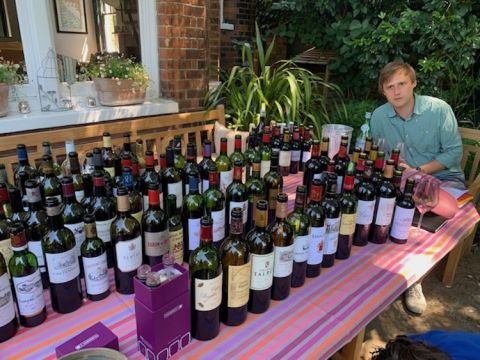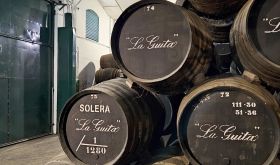From €20, £25.95, 685 Czech koruna, $37.30, HK$3,624 per case of 12, AU$74.99
COVID-19 lockdown has of course had myriad effects on our lives, and the wine industry is no exception. The elimination of face-to-face events has been a particularly visible aspect of that. It has wiped out major parts of the calendar, not least the cancellation of key trade show ProWein, and hamstrung others, such as the 2019 Bordeaux en primeur campaign (see When the tasting has to stop).
It has also choked the regular, day-to-day conduct of the wine trade, including the mass trade events, and the travel or consumer events that collectively oil the wheels of the wine trade. What has been fascinating, though, is to see how wine people have adapted to this to keep business going.
Many organisations have adopted Zoom or other virtual connectivity technology, just as has happened in many aspects of work and home life, setting up virtual tutored tastings, with the added advantage of being able to dial winemakers in from anywhere in the world. Some have been more creative and constructed a virtual tour of a wine region, adding local foods and a tourist map to the wine samples, and with winemakers live in the vineyards. See our guide to Wine online – lockdown learning.
And samples are of course the critical challenge, given that digitising the product itself is impossible. The logistical, economic and quality barriers of getting liquid to lips have had to be overcome. There have been a range of approaches here too: some producers have sent full bottles (safe, but expensive) while others have created smaller samples (cheaper, but more work and more risk of oxidation), while fine-wine traders Farr Vintners of London and Hong Kong – who were against holding a Bordeaux 2019 en primeur campaign in the middle of a pandemic – are now making a big deal of collecting 150 samples in Bordeaux themselves and driving them back to London for a socially distanced company tasting in the chairman's garden. Our Tom Parker MW is seen below contemplating the vintage – and the prospect of having to write tasting notes on all those wines.
Of course there are hiccups, from the vagaries of couriers (I have had deliveries never arriving at all, through to coming one hour after getting a notification that they would be delivered the next day), to the tech itself being temperamental from time to time.
Nevertheless, it’s good to see people experimenting as it is likely that some variations of these remote approaches will persist post-pandemic. Practice and technological advancement should improve things and there is doubtless a future for virtual tasting engagement, not least because it can reduce the need for wine producers to travel – even if it is unlikely to become the norm.
One organisation got in on the act early and has been particularly busy. 67 Pall Mall is London’s (and soon, Singapore’s) wine-orientated private members’ club. Head of wine Ronan Sayburn MS quickly curated an astounding number of diverse tastings, several of which have been compered by our very own Richard Hemming MW.
An early one of these has provided today’s wine of the week. Long a fan of the fine Mosel wines of J J Prüm, I was attracted by a tasting of six wines from the estate, introduced by Dr Katharina Prüm and her export manager Mihailo Martinovic. 67 Pall Mall have opted to prepare individual 7 cl sample bottles, like those pictured above, which members can choose to buy to accompany the tastings. I duly did.
This demonstrated one of the added strengths of such a virtual event: it didn’t matter that I’d ordered the samples too late for them to arrive in time, nor that I ultimately couldn’t make the live broadcast. It was recorded, so, having tasted the wines at leisure, I could simply catch up with the recording. It's towards the bottom of the list here.
It also provided an example of the risks: only two of the six tasting vials made it through the post intact; sadly two had popped open, including the sample of 2003 Auslese Goldkapsel. Shame! But of the four that arrived safely, two wines stood out.
One was the 2018 vintage of Julia’s 2018 wine of the week, J J Prüm, Graacher Himmelreich Kabinett 2016 Mosel. In her description Julia mentioned the relative dryness of their style and Katharina explained that their Kabinetts normally have around 30 g/l of sugar, compared with 45–60 g/l for the Kabinetts of other producers. In the 2018, this is very clear; while initially there is certainly an off-dry sense, its mid palate and finish are distinctly dry, with a slaty, flinty finish.
But it is J J Prüm, Bernkasteler Badstube Riesling Spätlese 2016 Mosel that is my wine of the week, for three reasons. First, it’s a beautifully balanced Spätlese, with exactly the right amount of cleansing acidity to work in harmony with the medium level of sweetness – around 60 g/l of sugar in their Spätlesen.
In this style, a Spätlese makes a fantastic food pairing with shellfish, by simultaneously marrying sweetness to the sweet flesh of, say, grilled prawns, while giving them a metaphorical squeeze of lemon. If there’s a touch of chilli involved, even better. Indeed, Katharina noted that Spätlesen and higher Prädikat wines are better with spicy dishes than the lighter Kabinetts.
Second, this particular example, from the Bernkasteler Badstube vineyard, is quite forward. As Julia noted in her wine of the week, Prüm wines can be flinty and reductive in their youth, needing some time to come around. But this was already showing lemon, fresh quince and floral notes on the nose, and even a touch of waxy maturity.
In their virtual commentary, Katharina and Mihailo explained that the flatter, west-facing Bernkasteler Badstube vineyard tends to produce earlier-drinking wines. While I think this will drink for the next couple of decades, I certainly found it to be on great form now.
Finally, it’s a good wine! Its delightful balance, as well as lovely length, floral finish, elevated it to a score of 17.5/20. And with prices starting at €20 in mainland Europe, £25.95 from UK importers Corney & Barrow, and from $37.30 after sales tax in the US, it’s reasonably priced, too.
















